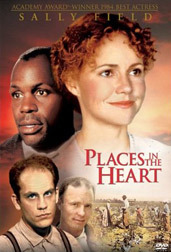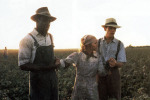Places in the Heart (1984) ESL

« Back to the original version
In “Places in the Heart” (1984), writer/director Robert Benton tells us about a way of life as it once was in the deep South of the U.S. during the Great Depression of the 1930s. The main character of Edna Spalding is played by Sally Field. Edna suddenly becomes a widow. Her police officer husband is killed while on duty.
 Edna must now face life as a widow with two young children. Edna seems to represent many women of her generation. She is not prepared to deal with the harsh realities of life as a single parent. It is still very much a man’s world. She doesn’t even know how to write out a cheque. She certainly does not know how to run a farm and earn a living. Sally Field’s character,
Edna must now face life as a widow with two young children. Edna seems to represent many women of her generation. She is not prepared to deal with the harsh realities of life as a single parent. It is still very much a man’s world. She doesn’t even know how to write out a cheque. She certainly does not know how to run a farm and earn a living. Sally Field’s character, Edna, demonstrates courage, warmth and toughness even though she faces great problems. She attempts to keep her family together during a deep economic and personal crisis.
Edna, demonstrates courage, warmth and toughness even though she faces great problems. She attempts to keep her family together during a deep economic and personal crisis.
 Danny Glover plays the part of Moze. Moze is a migrant worker who ends up helping Edna to work the farm and bring in the cotton. Glover captures what it means to be a black man in this period of time. Moze searches not only for work to keep body and soul together, but for dignity to make life worth living. He finds both work and diginity for a short time with Mizz Spalding on a little farm just outside of the small town of Waxahachie, Texas.
Danny Glover plays the part of Moze. Moze is a migrant worker who ends up helping Edna to work the farm and bring in the cotton. Glover captures what it means to be a black man in this period of time. Moze searches not only for work to keep body and soul together, but for dignity to make life worth living. He finds both work and diginity for a short time with Mizz Spalding on a little farm just outside of the small town of Waxahachie, Texas.
 John Malkovich plays Mr. Will. Mr. Will is a complicated character whose injuries from the First Great War involve more than just the loss of his eyesight. He rents a room from Mizz Spalding and joins the household. Mr. Will temporarily finds a place to belong. He finds a group of people who need him almost as much as he needs to be needed.
John Malkovich plays Mr. Will. Mr. Will is a complicated character whose injuries from the First Great War involve more than just the loss of his eyesight. He rents a room from Mizz Spalding and joins the household. Mr. Will temporarily finds a place to belong. He finds a group of people who need him almost as much as he needs to be needed.
Robert Benton, the writer and director of this film, presents this movie as a semi-autobiographical work. There are two hymns that open and close the film. They form bookends for the movie. These scenes, accompanied by music, set up a  context for understanding the rest of the action of the film. In the middle of the film, there is some very memorable folk music with unusal irregular rhythms. The folk songs are about picking cotton. They are songs that perhaps the migrant workers would sing. (Cotton-Eyed Joe for example.)The music comes out of the real life experiences of the townspeople. The music is presented as something that’s a part of what the people here really live. It’s not just an ornament for the dramatic action.
context for understanding the rest of the action of the film. In the middle of the film, there is some very memorable folk music with unusal irregular rhythms. The folk songs are about picking cotton. They are songs that perhaps the migrant workers would sing. (Cotton-Eyed Joe for example.)The music comes out of the real life experiences of the townspeople. The music is presented as something that’s a part of what the people here really live. It’s not just an ornament for the dramatic action.
The final scene of the movie is the scene with the communion service in church. It raises particular issues. Everything else in the film has been very  realisic until the final scenes of the film. Why is it that unreality suddenly takes over? Edna’s dead husband and his killer suddenly appear sitting side by side in church. (The young black man who accidntally shot the police officer was later brutally murdered by a lynch mob of Ku Klux Klansmen.)Sitting there in the pew, the dead husband and the deceased young black man seem as normal as every other member of the community as the communion plate is passed. My thought is that by including this unusual unrealistic element,
realisic until the final scenes of the film. Why is it that unreality suddenly takes over? Edna’s dead husband and his killer suddenly appear sitting side by side in church. (The young black man who accidntally shot the police officer was later brutally murdered by a lynch mob of Ku Klux Klansmen.)Sitting there in the pew, the dead husband and the deceased young black man seem as normal as every other member of the community as the communion plate is passed. My thought is that by including this unusual unrealistic element,  Robert Benton wants to show us something about his main characters and the community they live in.
Robert Benton wants to show us something about his main characters and the community they live in.
“Places in the Heart” is a very memorable story about a place and a time that no longer exist. The magic in it is that Benton manages to help us to understand something of what it was like to live back there and back then, just as he lived it when he was a boy in his hometown.




Reader Comments